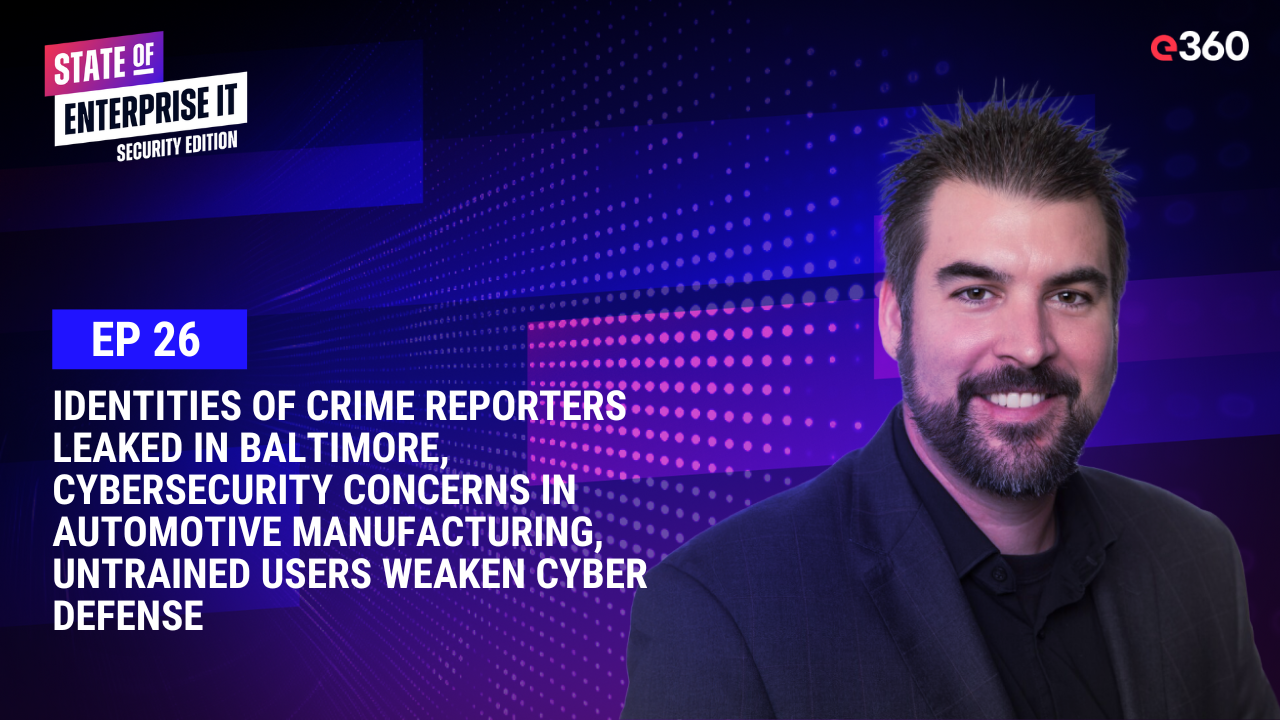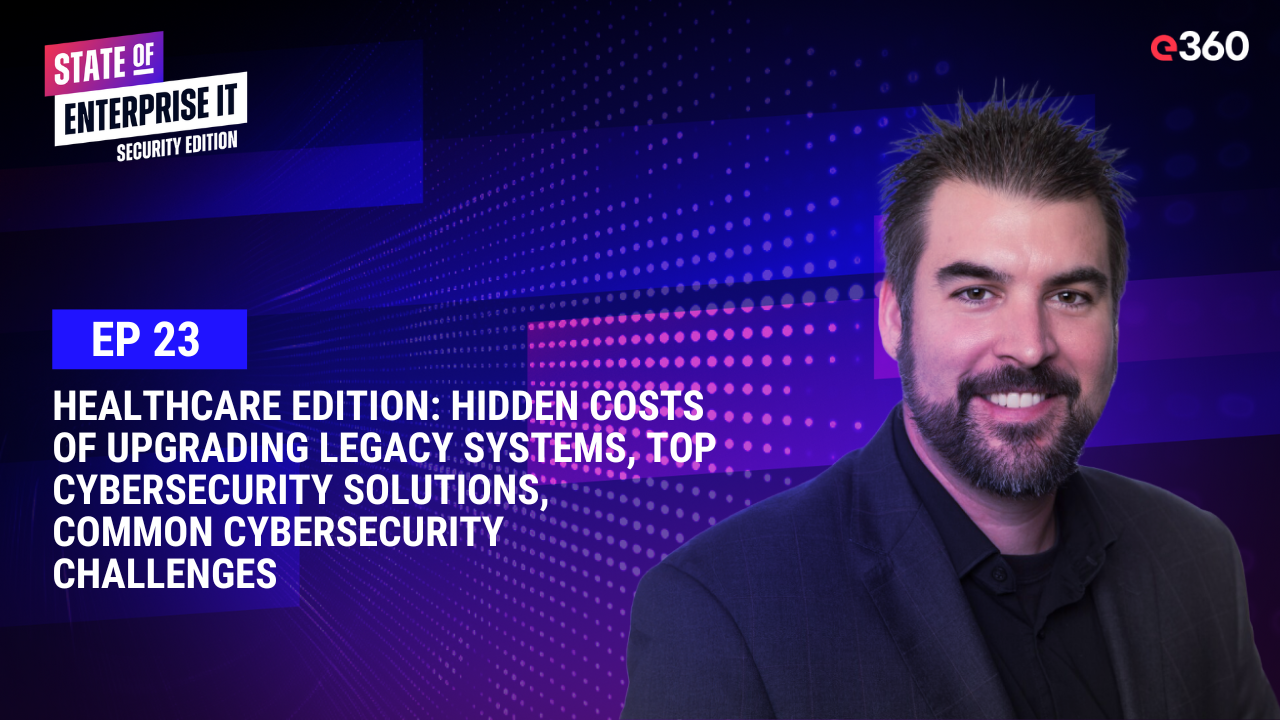Overview:
In this episode of the State of Enterprise IT Security Edition, Brad Bussie, Chief Information Security Officer at e360, covers three critical topics in the cybersecurity space. He discusses a significant data exposure incident in Baltimore City that compromised the identities of residents who reported crimes, underscoring the importance of robust data protection for public services.
Next, Bussie explores why cybersecurity has become a top concern for automotive manufacturers amidst the rise of connected and autonomous vehicles. Finally, he talks about how untrained users are the greatest weakness in a cyber defense plan, emphasizing the need for comprehensive cybersecurity training and a security-aware culture within organizations.
Key Topics:
What Baltimore’s 311 Data Breach Tells Us About Cybersecurity and Public Safety: The Baltimore 311 data breach exposes severe risks to public safety and underscores the need for robust cybersecurity measures in public services.
How Hackers Target Cars: The Growing Need for Automotive Cybersecurity: As connected and autonomous vehicles become more common, the automotive industry faces escalating cybersecurity threats that demand comprehensive protective strategies.
Why Untrained Employees Are Cybersecurity’s Greatest Vulnerability: Human error remains the leading cause of security breaches, making untrained employees the biggest weakness in any cyber defense plan.
Listen to the Episode:
Watch the Episode:
Episode 26: Identities of Crime Reporters Leaked in Baltimore, Cybersecurity Concerns in Automotive Manufacturing, Untrained Users Weaken Cyber Defense
[00:00:00] Really with the rise of connected cars. autonomous driving, and the increasing integration of digital technologies in vehicle, the stakes have never been higher.
[00:00:20] Hey, everyone. I'm Brad Bussie, Chief Information Security Officer at e360. Thank you for joining me for the State of Enterprise IT Security Edition. This is the show that makes IT security approachable and actionable for technology leaders. I'm happy to bring you three topics this week. First off, identities of residents who reported crimes leaked.
[00:00:45] In one of America's deadliest cities. Second new study finds cybersecurity as top concern among automotive manufacturers and third untrained users are the greatest weakness in a cyber defense plan. And with that, let's get started.
What Baltimore’s 311 Data Breach Tells Us About Cybersecurity and Public Safety
[00:01:05] . So first topic, the identities of residents who reported crimes in one of America's deadliest cities.
[00:01:14] And I wanted to talk about the story as it underscores the critical importance of protecting personal data, especially when it comes to public services. I mean, there was a significant data exposure incident, and this was involving Baltimore City's 311 services. And this was back in May, and a well known cyber research team, They actually discovered publicly accessible, e360 Kibana instance, which belongs to the city of Baltimore.
[00:01:54] And this instance exposed a database that was [00:02:00] lacking proper authentication and authorization mechanisms. And it contained sensitive data from the city's 311 service. And if you're not familiar, e360 the 311 service was originally a non emergency phone line. Now it allows residents to interact via a website or an app and submitting various types of reports as well as complaints.
[00:02:26] e360 the exposed data included a crazy amount of reports, like 13.5 million reports. submitted since 1989 and this information compromised names, email addresses, and phone numbers of individuals who used the service. And the database revealed a wide array of reports such as traffic accidents, housing sanitation complaints, road quality issues, speed camera statuses, it was like animal control complaints, and even accusations of illegal activities.
[00:03:11] Now, while some of these reports are typically made public by the city's government, really the sheer volume and detail of the personal information in the database went far beyond what is usually disclosed. So the exposure of such a vast amount of personal data severely threatens the privacy and safety of Baltimore's residents.
[00:03:39] Especially concerning is the fact that some residents used the 311 service to report criminal activities and given Baltimore's high homicide rate, Revealing the identities of individuals who reported crimes could place them in significant danger. [00:04:00] I mean, imagine reporting a crime in good faith, believing your identity would remain confidential, only to find out that your personal details are publicly accessible.
[00:04:11] So this scenario is not just a privacy issue, but a serious safety concern. It highlights the critical need. For robust data protection measures, particularly for services that handle sensitive and potentially dangerous information. So I wanted to note that the exposed instance is no longer publicly accessible and highlights accountability and swift action when such vulnerabilities are discovered.
[00:04:44] And honestly, the biggest thing I'm worried about with this one is possible reprisals on people who reported potential crimes. And this incident serves as a reminder of the importance of securing digital infrastructure, especially for public services. And I'm sure, you know, by now I'm going to highlight what can be done to keep this from happening again.
[00:05:11] So implement robust security measures, ensure that all public facing databases have proper authentication and authorization mechanisms to prevent unauthorized access, conduct regular security audits. Audit and vulnerability assessments are key to identifying and mitigating potential risks. Data minimization, only collect and store the minimum amount of personal data necessary for service provision.
[00:05:46] This reduces the risk in case of a data breach. And public awareness, inform the public about the types of data collected And how it is protected to build [00:06:00] trust and ensure transparency
How Hackers Target Cars: The Growing Need for Automotive Cybersecurity
[00:06:04] . Second topic for today, new studies find cybersecurity as the top concern among automotive manufacturers. Now, why has cybersecurity become a top concern among automotive manufacturers?
[00:06:21] Really with the rise of connected cars. autonomous driving, and the increasing integration of digital technologies in vehicle, the stakes have never been higher. Automotive manufacturers, they're, they're rapidly advancing in the development of connected and autonomous vehicles. And these technologies promise enhanced safety, convenience, and efficiency, but They also open up a multitude of cybersecurity vulnerabilities and connected vehicles communicate with external systems and infrastructure, making them potential targets for cyber attacks.
[00:07:09] Hackers could exploit these connections to gain unauthorized access, potentially taking control of vehicle functions or stealing sensitive data. And several high profile incidents have highlighted the vulnerabilities in automotive cybersecurity. I'd say one notable example is, like a 2015 Jeep Cherokee that was hacked.
[00:07:39] And the security researchers demonstrated that they could remotely control the vehicle. Manipulating its steering, brakes, and transmission. And this incident raised significant alarm within the industry and underscores the urgent need [00:08:00] for robust cybersecurity measures. Another example is the discovery of vulnerabilities in Tesla's autopilot system.
[00:08:11] Where researchers were able to trick the car into changing lanes or stopping unexpectedly by placing stickers on the road. And these incidents illustrate how seemingly minor security flaws can have major safety implications. And cyber security concerns in the automotive industry are not just about protecting data.
[00:08:39] They're also about ensuring the physical safety of drivers and passengers. A successful cyber attack on a vehicle can lead to accidents, injuries, or even fatalities. As vehicles collecting, e360 increasing amounts of data, and that includes personal information about drivers, protecting this data from breaches is crucial for maintaining consumer trust.
[00:09:11] as well as complying with privacy regulations. Now the automotive industry faces a complex landscape of regulatory and compliance requirements, all related to cybersecurity. For instance, the European Union's GDPR regulation imposes strict rules on how personal data must be handled and protected.
[00:09:40] Additionally, The United Nations Economic Commission for Europe. They have introduced regulations specifically targeting automotive cybersecurity and software updates. Manufacturers really need to navigate these regulations to [00:10:00] avoid fines. And ensure their vehicles meet global cybersecurity standard. To address these challenges, automotive manufacturers are adopting several key strategies.
[00:10:14] First, secure development practices. This is integrating cybersecurity from the earliest stages of vehicle design and development, which ensures that security is built into the product rather than added as an afterthought. Second, regular software updates. This is providing timely updates and patches for vehicle software, which helps to address new vulnerabilities as they are discovered.
[00:10:46] Third, collaborating and information sharing. So working with industry consortia and regulatory bodies to share information about threats and best practices. which enhances the overall security posture of the automotive industry. And fourth, testing and validation. So conducting rigorous tests, including penetration testing and vulnerability assessments, which helps to identify and mitigate potential security issues before they can be exploited.
[00:11:25] Third topic for today
Why Untrained Employees Are Cybersecurity’s Greatest Vulnerability
[00:11:28] . Why untrained users are often considered the greatest weakness in a cyber defense plan. So let's explore the various dimensions of this issue and understand its implications for organizations. Now, cybersecurity experts often emphasize that human error is a leading cause of security breaches.
[00:11:57] Despite having [00:12:00] robust technical defenses in place, many organizations fall victim to cyber attacks due to mistakes made by untrained or poorly trained employees. And these errors can include clicking on phishing links, using weak passwords, mishandling sensitive information. Or just failing to follow security protocols.
[00:12:24] And one of the most common ways cyber criminals exploit untrained users is through phishing attacks and phishing continues to involve tricking individuals into providing sensitive information or clicking on malicious links by pretending to be a legitimate entity. Social engineering attacks continue to prey on human psychology.
[00:12:52] Such as curiosity, fear, or a desire to help, which makes even the most cautious users vulnerable if they're not properly trained and a well known example is the 2016 Democratic National Committee hack where phishing emails were used to gain access to the email accounts of key officials. This incident underscores how easily sophisticated attacks can bypass technological defenses.
[00:13:29] If users are not vigilant, user errors can have significant financial and reputational impacts on organizations. IBM found that the average cost of a data breach with this was in 2020 was 3.86 million. Furthermore, breaches resulting from human error or negligence often take longer to identify and contain, which makes their impact [00:14:00] even worse.
[00:14:01] And beyond the immediate financial costs, breaches can damage an organization's reputation, erode customer trust, and lead to legal and regulatory challenges. For instance, the Equifax data breach, this is back in 2017, exposed the personal information of 147 million people. And this was partially attributed to a failure to apply a security update.
[00:14:32] And this incident resulted in severe financial penalties and I would say a lasting dent in the company's reputation. So comprehensive cyber security training. It's essential to mitigate the risks posed by untrained users. And this training should cover recognizing phishing attempts. So employees should be trained to identify suspicious emails and messages and know what steps to take if they encounter one.
[00:15:08] Password security emphasizing the importance of using strong, unique passwords and utilizing password managers or just getting rid of passwords, e360 data handling practices. So educating employees on how to handle sensitive information securely and the importance of encryption. And then there's incident reporting.
[00:15:33] Encourage a culture where employees report potential security incidents. promptly and without fear of reprisal. And beyond formal training sessions, creating a security aware culture within an organization is crucial. So this involves regular updates on emerging threats, ongoing education, and [00:16:00] promoting an environment where cybersecurity is everyone's responsibility.
[00:16:05] Leadership should model. practices and recognize employees who contribute to the organization's security posture. So in conclusion, untrained users are often the greatest weakness in a cyber defense plan because human error can bypass even the most advanced technical defenses. Phishing attacks, social engineering, and mishandling of sensitive information are just a few examples of how untrained users can inadvertently compromise security.
[00:16:46] So by investing in comprehensive training and fostering a security aware culture, organizations can significantly reduce these risks and strengthen their overall cybersecurity posture
Conclusion and Final Thoughts
[00:17:02] . So that's all for today's episode of the State of Enterprise IT Security Edition. If you found this discussion valuable, don't forget to subscribe and share it with your network.
[00:17:14] Stay tuned for more insights into the critical issues shaping the world of cybersecurity. And until next time, stay safe.



